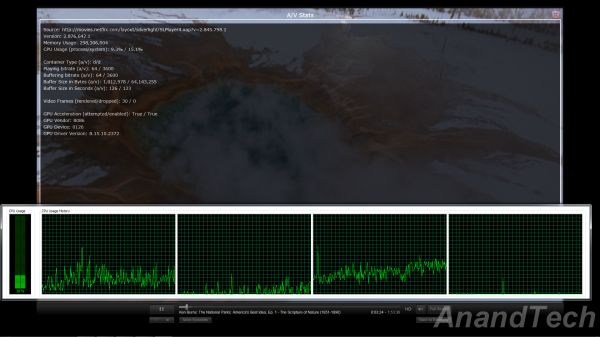ASRock CoreHT 252B Review
by Ganesh T S on September 2, 2011 3:45 AM EST- Posted in
- HTPC
- Intel
- ASRock
- Media Streamer
The ASRock CoreHT 252B is covered quite nicely with respect to networking hardware. With support for both Gigabit Ethernet and 802.11n, it really doesn't matter if you keep the unit beyond cable reach from the router. All our network streaming tests were carried out with a 300 Mbps 802.11n network (currently provided in my lab location by a RT-N16 802.11n gigabit router from Asus). We were easily able to stream HD clips of more than 50 Mbps. HD YouTube videos and HD Netflix streaming had no issues.
While on the topic of network streaming, let us take a brief look at how the system performs while accessing online video services. We used Flash 10.3 in Firefox 4 with Intel Graphics Driver v2372 for testing. The first set of screenshots below show the CPU usage while playing back a 1080p YouTube video with and without hardware acceleration enabled. This is the same clip used in all the other SFF HTPC reviews.
1080p YouTube HD Streaming without Hardware Acceleration

1080p YouTube HD Streaming with Hardware Acceleration (Flash in Firefox)
Unfortunately, enabling hardware acceleration in the Flash properties seems to result in only accelerated video rendering. The decode still ends up being done in software. This accounts for the ~5% decrease in CPU usage when hardware acceleration is enabled. Just before posting the review, we also confirmed that the issue still exists on IE9 / Firefox 6.0 with Flash 10.3.183.7. Another puzzling aspect was the fact that we could get hardware accelerated decoding for some videos occasionally.

1080p YouTube HD Streaming with Hardware Acceleration (Flash in IE9)
It looks like the Adobe Flash Player has some trouble in hooking up to the Intel DXVA library. Both AMD and NVIDIA platforms support GPU acceleration for Flash without issues. It is disappointing to note that the largest GPU vendor (in terms of install base) still hasn't got this working right.
Netflix streaming, on the other hand, uses Microsoft's Silverlight technology. Unlike Flash, hardware acceleration for the video decode process is not controlled by the user. It is upto the server side code to attempt GPU acceleration. Thankfully, Netflix does try to take advantage of the GPU's capabilities. This is evident from the A/V stats recorded while streaming a Netflix HD video at the maximum possible bitrate of 3.8 Mbps. While the video is definitely not 1080p, we observe that the CPU utilization of around 18% is lower than the CPU usage for a 1080p YouTube video.

Netflix HD Streaming with Hardware Acceleration
Users of media streamers streaming online videos often have to put up with messages of the sort 'This content is not available on TV connected devices' or need to queue up the videos on a PC before accessing them through their media streamer box. HTPC users don't need to worry about any such limitations.
On a side note, it is disappointing to see Netflix restrict its 1080p / DD+ 5.1 offerings to the PS3 and Roku 2. It is the PC platform which launched the streaming business for Netflix. It would be good if they do not relegate HTPC users to being second string consumers as their popularity grows.











54 Comments
View All Comments
casteve - Friday, September 2, 2011 - link
page 3, GPU paragraph:"However, WiDi is supported by the CoreHT 252B. "
I think you meant to say NOT supported.
Great article! Thanks, Ganesh.
ganeshts - Friday, September 2, 2011 - link
Thansk! Fixed.jensend - Friday, September 2, 2011 - link
If somebody made a system like this with a 65W Llano, esp. an A8-3800, I'd be all over it. Mobile Llano would be ok as well. (Barebones would be nice- I'd like to put in my own small ssd, and I have no need for Blu-Ray.)Foggg - Friday, September 2, 2011 - link
I thought there was a chance that ASRock's next level "Vision 3D series" which Ganesh referred to was possibly so-named because of AMD's "Vision" labeling for the Llano's.No such luck. That series has mobile i7's/i5's/i3's paired with Nvidia's GT425M. Guaranteed to be pricier than a mobile Llano. And for most, unnecessary, given this uses for this thing.
smdx - Friday, September 2, 2011 - link
Following the last comment, is there any news on a possible update for the ZInoHD 410 line? (I guess they will be using Llano on their next lineup)Last year model was presented in September 2010...
Don't know in Anandtech has any feedback on this...
jabber - Friday, September 2, 2011 - link
Yeah would be nice. I got one in for a customer and he loves it. I thought it a great bit of kit.Shadowmaster625 - Friday, September 2, 2011 - link
I would like to see performance and power consumption comparisons to a desktop running an i3-2105. I suspect they are close, even though the i3 costs significantly less. My scam radar is going off like crazy here. Since when is a small form factor worth that much? Why not just buy a notebook and use that as your HTPC???? That is a much higher volume product and thus it is highly likely you'll be able to find one on sale for cheaper than this product.Shadowmaster625 - Friday, September 2, 2011 - link
Just saw these on slickdeals:Sony VPC EG13FX/B 14" Notebook - i5 / 500GB / 4GB RAM - $549 @ Frys
(New) ThinkPad Edge E420/ i5-2520M/ Win7 HP 64/ 2GB/ 320GB/ 9-Cell for $488 @ lenovo outlet
ganeshts - Friday, September 2, 2011 - link
Yes, a laptop can be a portable HTPC nowadays.As you say, pricing is just a matter of scale. I would expect this to weigh in around the 500 - 600 range. Laptops are mass produced. So, they have an advantage there.
justniz - Friday, September 2, 2011 - link
I'm looking for a mythtv frontend.But this thing has Intel graphics and you can't buy it without windows.
What stupid marketing decisions. I think I'll pass.
I would have bought one if they had a nVidia GPU and a no-OS or Linux option.